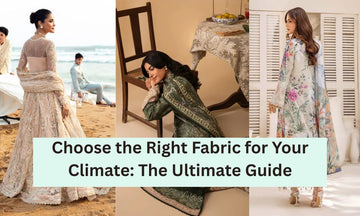Choosing the appropriate fabric for your region is essential to achieving comfort, style, and ultimate performance under all weather conditions. As temperatures go up, materials such as cotton, linen or silk still provide good cooling, but during cold weather, wool, fleece or down are useful to insulate you. Water-wicking material does exceptionally well in hot climates, helping you to stay dry. Regular use of textiles that suit your environment can guarantee that you are always relaxed anywhere. Find out how your preference for a fabric impacts your experience and learn all about the criteria for choosing optimal materials for any climate with this guide.
Why Fabric Choice Matters
Fabric selection is more about what it does for you than how it looks. Choosing the right fabric promotes temperature regulation, avoids sweat accumulation, and provides a shield from rough weather. With material characteristics in mind, you can choose clothes better suited for the daily life and climate you come from.
Key factors to consider include:
-
Breathability: Facilitates airflow for no overheating in warm conditions.
-
Insulation: Helps keep warmth in; it captures body heat at colder temperatures.
-
Moisture Management: Some fabrics draw moisture away from the body while others retain the moisture and thereby offer the kind of comfort.
-
Durability: Remains hard wearing and durable, can be used often and worn many times in the washer without showing any signs of wear and tear.
Discover a wide range of Pakistani clothes online, featuring traditional designs and modern styles perfect for every occasion.
Fabrics for Hot and Humid Climates
Choose breathable light fabrics on warm days and feel more comfortable. Through allowing airflow, these textiles allow for the maintenance of a comfortable and cool body temperature.
Cotton
-
Cotton is the preferred material for hot climates due to its softness, breathability, and excellent absorption of sweat. Cotton is an ideal choice for extreme hot and humid climates as it helps you feel cool and improves comfort. For people who reside in humid climates, the cotton gets moist and absorbs extra moisture from the skin, thus reducing stickiness and allowing for greater comfort. In such warm and sticky days, a thin cotton shirt or dress could make a real difference.
-
Lawn Cotton: Most breathable with a low weight, good for summer wardrobes when you dress casually or for the office.
-
Voile Cotton: Elegant and airy, sophisticated and yet cool enough to please the skin.
Linen
Linen is well known for having a superior ability to pull moisture away and leave you feeling refreshed. The laid-back, rustic look of the material’s natural finish and the breathability provided make the material ideal for tropical environments. Complete your summer wardrobe with linen shirts or trousers that are harmonized in neutral colours to make you look elegant.
Bamboo Fabric
With the increased use of bamboo textiles, they are appreciated due to their sustainable production and their remarkable ability to control temperature. Linen is valued for these fabrics’ ability to absorb moisture and take away the negative side of humidity. The relaxed look and its airy feeling are perfect when humidity increases. Its exceptional breathability makes it ideal for individuals having sensitive skin.
Fabrics for Cold Climates
To stand in frigid temperatures, seek materials that are meant to be warm and comfortable. By retaining heat, these fabrics give long-term soothing even on bare coldest days.
Wool
Wool is an old material which is appropriate for cold weather environments. The wool fibers retain air creating a good barrier to protect you from the cold exterior. The soft texture and moisture-wicking mechanism of the Merino wool make it ideal for use in sweaters, scarves, and for use as a base layer.
Fleece
In contrast with wool, fleece is a synthetic product, which provides warmth but without an unnecessary layering. Its breathability and the capability to dry quickly make wool a useful layer both in the middle and the outer layer of your winter set.
Thermal Knit
Thermal knits are designed to hold the heat, which is why they’re excellent layering pieces for really cold temperatures. Their application in thermal tops and leggings helps support and provides additional insulation.
Explore the finest Pakistani designer wear, showcasing exclusive collections from top fashion brands.
Fabrics for Transitional Weather
As some may be familiar with the unpredictability of spring and autumn weather, it is good to be equipped with clothing that can cope with a temperature change.
Denim
The practicality of Denim makes it the perfect option for the intermediate as well as for the overlaps between the seasons. With its ability to withstand wear and tear, and weight that is midway between light and heavy, denim makes a great choice for layering or for everyday wear, without a jacket. Choosing a light denim jacket or jeans is a good idea for going for breezy days and keeping warm on cooler evenings.
Blended Fabrics
Combination of natural and man-made materials in clothes guarantees comfort as well as long-term strength. Consider a cotton-polyester blend, as it balances letting you stay cool as well as letting you stay dry with everyday wear in mild conditions.
Specialised Fabrics for Active Lifestyles
If you have a vibrant lifestyle or experience various weather (and why not!), using specialist fabrics will increase your experience many times over.
Moisture-Wicking Fabrics
Removal of sweat from the body is made efficient by wearing polyester or nylon-based moisture-wicking fabrics. These fabrics are particularly useful for exercise, outdoor, or trail activities if it is hot.
Quick-Drying Fabrics
Rainy or humid weather is where excellent comfort can be found in the form of quick-drying fabrics. Lightweight synths such as microfiber-based fabrics are good at preventing moisture, and they are quick to dry, ensuring you are comfortable and dry, all day.
Experience the convenience of shopping for online Pakistani clothes, with authentic designs delivered to your doorstep.
Tips for Choosing the Right Fabric
-
Match Fabric to Climate: Bear your climate and daily activities in mind when selecting fabrics. In warmer climes, choose breathable material in the likes of cotton and linen, while in colder it’s time to use insulating fabrics such as wool and fleece.
-
Think Sustainability: Wearing items from eco-friendly fabrics like bamboo and organic cotton will help to reduce your environmental impact.
-
Experiment with Blends: In case combining fabrics you can easily get a perfect balance, where you will enjoy not only comfort and reliability, but will look stylish also.
-
Prioritise Comfort: Ultimately, your dressing should believe in you, and not others, about how you feel, not what is fashionable.
Conclusion
Your choice of fabrics, depending on the climate, isn’t just comfort-of-choice; it’s a part of being more conscious of the way we live. Cotton and linen are great for the tropical heat, while wool and fleece are great for the winter biting cold. Therefore, if you consider your climate and fabric attributes, you are able to choose garments that take your wardrobe to a higher level and gain you better well-being.
When looking for clothes, also bear in mind that there are alternatives when it comes to fabrics. If you choose what fabrics you wear wisely, you can be not only warm but also stylish, easily accommodating any weather outside.




